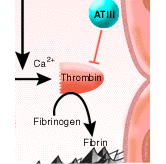How Blood Clots
 Scabby knees and bruised shins are as much a part of growing up as climbing trees. Minor injuries from paper cuts to skinned elbows are nothing to worry about for most people, because the blood's natural clotting process swings into action whenever the skin is broken or a blood vessel damaged. Clotting stops bleeding. Without it, even a small scrape could trigger massive blood loss.
Scabby knees and bruised shins are as much a part of growing up as climbing trees. Minor injuries from paper cuts to skinned elbows are nothing to worry about for most people, because the blood's natural clotting process swings into action whenever the skin is broken or a blood vessel damaged. Clotting stops bleeding. Without it, even a small scrape could trigger massive blood loss.
Coagulation or clotting of blood involves a series of changes in several blood proteins and enzymes. Cells in damaged tissues release proteins that trigger it. Blood cells called platelets congregate at the injury site. They adhere to damaged tissue and form a plug. After that, some 20 different substances get into the act. Calcium and vitamin K from food are two of them. The result is the formation of a network of strings or threads called, aptly enough, fibrin. A scab on the skin is a mesh of fibrin with platelets and red blood cells trapped in it. A bruise forms at the site of an internal blood clot.
Blood clots are life-saving, but when they form inside blood vessels, they can be life-threatening. A clot can block a vital artery--for example, one that supplies the heart or brain with blood. If the blockage to the heart is severe enough, heart muscle cells are deprived of oxygen and they die. That is a heart attack. A serious blockage in the brain causes neurons to die. That is one kind of stroke. Another kind of stroke is bleeding in the brain. It happens when normal clotting mechanisms fail.
About the Author
Faith Brynie, Ph D
 Faith Brynie holds a B.A. in Biology from West Virginia University and an M.A. and Ph.D in science curriculum and instruction from the University of Colorado. She writes books and articles on science and health topics for children, teens, and non-scientist adults. Some of her books have won awards, including two 'Best Book of the Year' citations from the American Association for the Advancement of Science.
Faith Brynie holds a B.A. in Biology from West Virginia University and an M.A. and Ph.D in science curriculum and instruction from the University of Colorado. She writes books and articles on science and health topics for children, teens, and non-scientist adults. Some of her books have won awards, including two 'Best Book of the Year' citations from the American Association for the Advancement of Science.


